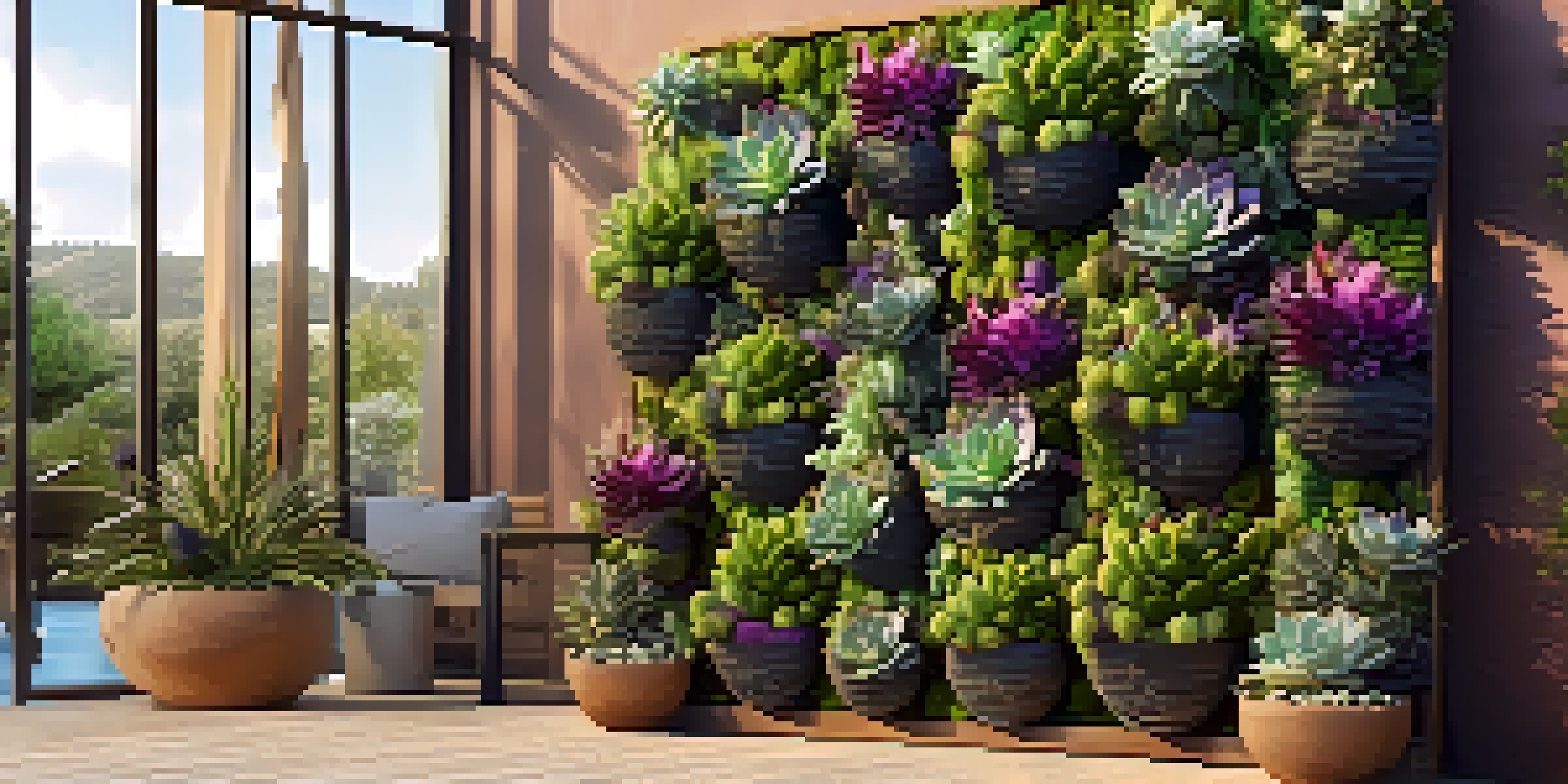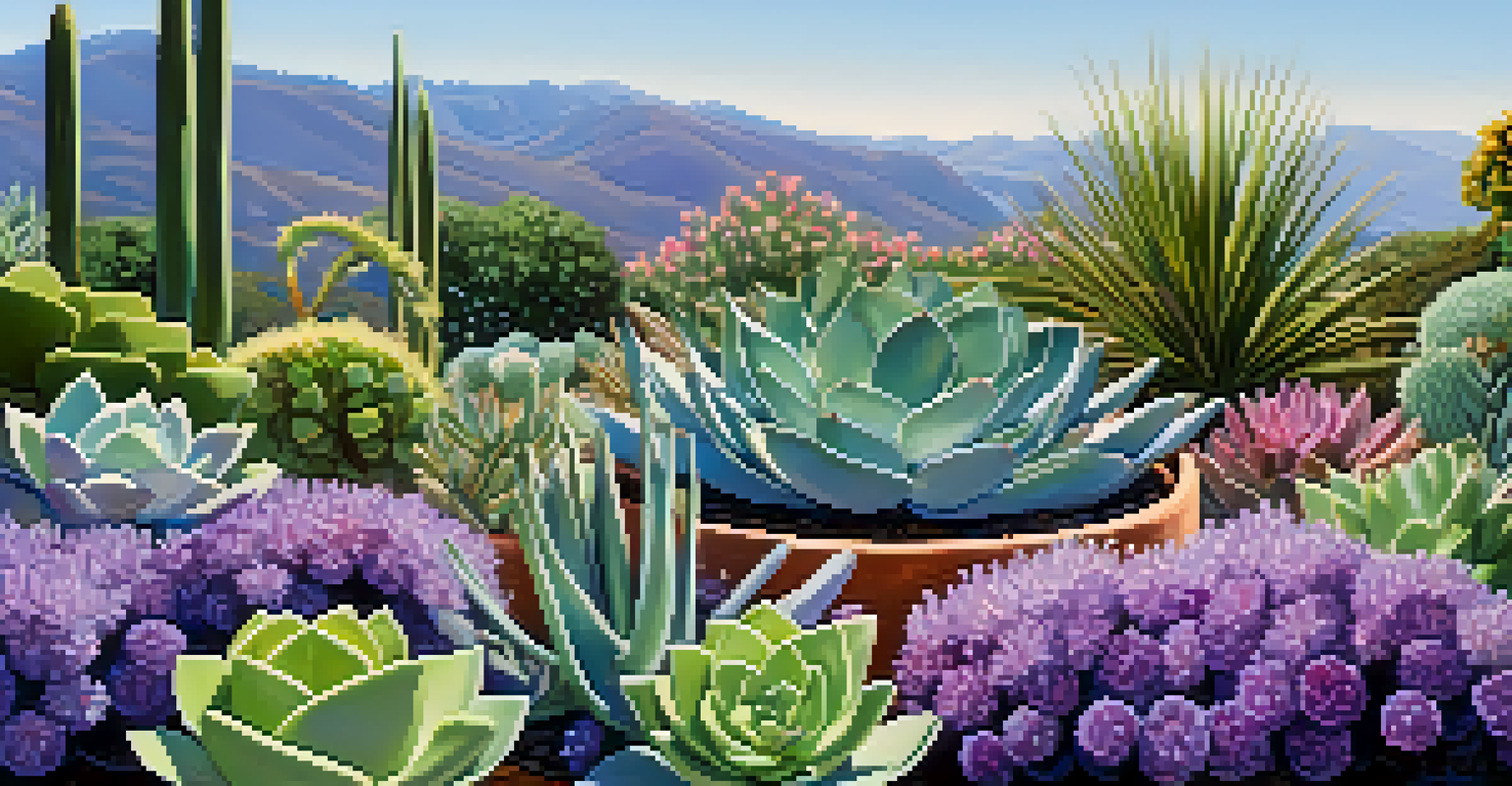The Role of Succulents in Water-Efficient Landscaping

Understanding Water-Efficient Landscaping Concepts
Water-efficient landscaping is all about creating beautiful outdoor spaces that minimize water use. It involves selecting plants and designs that thrive with minimal irrigation. By understanding its principles, homeowners can contribute to sustainability while enjoying a lush garden.
The best time to plant a tree was twenty years ago. The second best time is now.
At its core, this approach relies on native and drought-tolerant plants, which are well-adapted to local climates. This means less maintenance and lower water bills, a win-win for both your garden and your wallet. Succulents, with their unique water-storing abilities, play a vital role in this landscaping strategy.
Incorporating water-efficient landscaping not only helps in conserving water but also promotes biodiversity. It creates a balanced ecosystem, allowing various plants and animals to thrive together. This not only beautifies your space but also supports local wildlife.
Why Succulents Are Perfect for Drought Conditions
Succulents are incredibly resilient plants that have adapted to survive in arid environments. They store water in their leaves, stems, and roots, making them ideal for gardens that experience low rainfall. This unique adaptation allows them to thrive with minimal care while still providing visual appeal.

Their diverse shapes, sizes, and colors offer a wide range of design possibilities, ensuring that your landscape remains vibrant and interesting. For instance, the rosette shape of an Echeveria adds a modern touch, while the tall spines of an Agave create dramatic vertical interest. Such versatility makes succulents a favorite among landscape designers.
Water-Efficient Landscaping Benefits
Water-efficient landscaping conserves resources, reduces maintenance, and promotes biodiversity through the use of native and drought-tolerant plants.
Moreover, succulents can outcompete many traditional garden plants in drought conditions. Their ability to efficiently use water means they require less irrigation, making them a smart choice for eco-conscious gardeners. This not only conserves water but also reduces the need for chemical fertilizers and pesticides.
Designing with Succulents: Tips and Tricks
When incorporating succulents into your landscape, consider grouping them by water needs. This approach ensures that each plant receives the right amount of moisture while maximizing water efficiency. Creating diverse clusters can also enhance the aesthetic appeal of your garden.
Nature does not hurry, yet everything is accomplished.
Another tip is to use a variety of textures and colors to create visual interest. Mixing different types of succulents, such as fuzzy Echeveria with smooth Aloe, can add depth to your design. Don't shy away from using contrasting colors, like deep greens alongside vibrant reds and purples, to make your garden pop.
Finally, consider using succulents in unconventional spaces, such as vertical gardens or container arrangements. These creative designs can showcase your plants while saving ground space and water. Whether on a balcony or a small yard, succulents can transform any area into a stunning oasis.
The Role of Mulching in Succulent Care
Mulching is an essential practice for maintaining succulents in any landscape. By applying organic or decorative mulch around these plants, you can help retain soil moisture and suppress weeds. This is particularly important in water-efficient landscaping, where every drop counts.
Using materials like shredded bark, gravel, or decorative stones not only protects the soil but also adds an aesthetic element to your garden. For example, using light-colored stones can reflect sunlight, creating a warm, inviting space. This simple addition can enhance the overall appearance of your succulent garden.
Succulents Thrive in Drought
Succulents are ideal for dry conditions due to their unique ability to store water, requiring less irrigation while adding visual appeal.
Additionally, mulch can help regulate soil temperature, keeping roots cool during the hot months. This is crucial for succulents, as extreme heat can stress the plants. By providing this layer of protection, you can ensure that your succulents thrive year-round.
Complementing Succulents with Other Plants
While succulents are fantastic on their own, they can also be complemented by other drought-tolerant plants. Incorporating species like lavender or ornamental grasses can create a more dynamic landscape. The combination of textures and colors can elevate your garden's aesthetic appeal.
When selecting companion plants, consider those with similar watering needs to ensure harmony in your garden. For instance, pairing succulents with low-water perennials can create a well-balanced ecosystem. This synergy not only enhances beauty but also improves the overall health of your garden.
Moreover, diverse plant selection can attract beneficial insects and pollinators, contributing to a thriving garden ecosystem. By inviting bees and butterflies, you can ensure that your landscape remains vibrant and alive. This not only helps in pollination but also promotes biodiversity.
Maintenance Tips for Succulent Landscapes
Maintaining a succulent garden is relatively straightforward, but it does require some attention. Regularly checking for pests and diseases is crucial, as succulents can be vulnerable to infestations. By inspecting your plants frequently, you can catch any issues early and address them promptly.
Another important aspect of maintenance is proper watering techniques. While succulents are drought-tolerant, they still need water, especially during the growing season. A good rule of thumb is to water them deeply but infrequently, allowing the soil to dry out between waterings.
Enhancing Gardens with Companion Plants
Complementing succulents with other drought-tolerant plants creates a dynamic landscape that supports a balanced ecosystem and attracts beneficial wildlife.
Lastly, consider seasonal care for your succulents. During the cooler months, some varieties may enter dormancy and require even less water. Adjusting your care routine according to the seasons ensures your plants remain healthy and vibrant throughout the year.
The Environmental Impact of Using Succulents
Utilizing succulents in landscaping can have a significant positive impact on the environment. By reducing water usage, homeowners can help alleviate strain on local water resources, especially in drought-prone areas. This commitment to sustainability contributes to a healthier planet.
Moreover, succulents are often low-maintenance, which means less reliance on chemical fertilizers and pesticides. This reduction in chemicals can lead to healthier soil and contribute to cleaner water systems. By choosing succulents, you're not only beautifying your space but also protecting local ecosystems.

Additionally, planting succulents can promote biodiversity by providing habitats for various insects and animals. As these plants thrive, they create a balanced ecosystem that supports life. This interconnectedness highlights the importance of thoughtful landscaping choices in fostering environmental health.